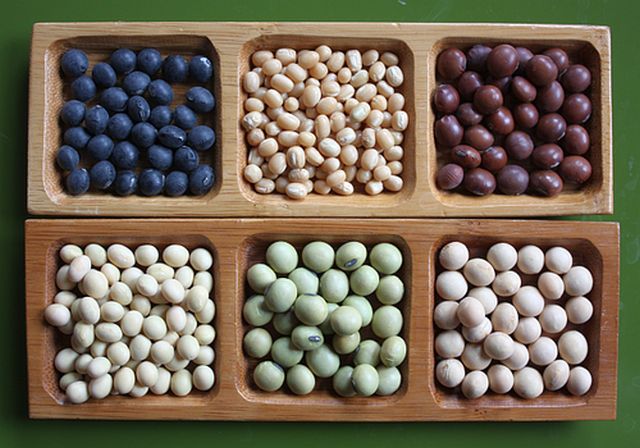How soybean is beneficial?
Soybeans are legumes related to peas, clover, and alfalfa. Soybeans are dicots, which means they have two cotyledons.
Each soybean plant produces 60 to 80 pods, each holding three pea-sized beans. Soybeans are hardy plants and well adapted to a variety of soils and soil conditions.
Soybeans also provide soy oil, which people can use for cooking or as an ingredient. After removing the oil from soybeans, people can use the remaining material to make food for farm animals and pets.
Green soybeans: Young green soybeans are also called edamame. People can steam them and eat them out of the pod as an appetizer. Shelled edamame is also available in salads, stir-fries, and soups.
Yellow soybeans: Producers typically use yellow soybeans to make soy milk, tofu, tempeh, and tamari. They also play a role in the production of soy flour for baking.
Black soybeans: Several Asian food cultures use simmered or fermented black soybeans in traditional dishes.

Table of Contents
Nutrition facts:
Nutritious Soybeans are mainly composed of protein but also contain several carbs and fat. The facts for 3.5 ounces (100grams) of boiled soybeans are:
●Calories:172
●Water:63%
●Protien:18.2 grams
●Carbohydrates:8.4 grams
●Sugar:3 grams
Protein:
Soybeans are among the best sources of plant-based protein. The protein content of soybean is 36-56% of dry weight. One cup (172 grams) of boiled soybeans boasts around 31 grams of protein.
The nutritious value of soy protein is very good although the quality is not quite as high as some animal proteins.
The main types of protein in soybean are glycinin and conglycinin, which make up approximately 80%of the total protein content. These proteins may trigger allergic reactions in some people. Consumption of soybean has been linked with a modest decrease in cholesterol level

Fat:
Soybean is classified as oilseeds and used to make soybean oil. The fat content is approximately 18% of the dry weight-mainly polyunsaturated and monounsaturated fatty acid with a small amount of saturated fat. The predominant type of fat in soybeans is linoleic acid, accounting for approximately 50% of the total fat content.

Carbohydrates:
Being low in carbohydrates, whole soybeans are very low on the glycemic index, which is a measure of how foods affect the rise in blood sugar after a meal. This low GI makes soybeans suitable for people with.

Fiber:
Soybean contains a fair amount of both soluble and insoluble fiber. The insoluble fibers are mainly alpha-galactosides, which may cause flatulence and diarrhea in sensitive individuals. Soluble fibers in soybeans are generally considered healthy.

Vitamins and minerals:
Soybeans are a good source of various vitamins and minerals, including:
●Molybdenum: Soybean is rich in molybdenum, an essential trace element primarily found in seeds, grains, and legumes.
●Vitamin K1: The form of vitamin K found in legumes is known as phylloquinone. it play important role in blood clotting.
●Folate: Also known as vitamin B9 folate has various functions in your body and is considered particularly important during pregnancy
●Copper: Dietary intake of copper is often low in the western population. Deficiency may have an adverse effect on heart health
●Manganese: A trace element found in most foods and drinking water. Manganese is poorly absorbed from soybean due to their high phytic acid content
Health benefits of soybeans:
Managing obesity
One 2019 study by Trusted Source in the journal Molecules looked at the effect of soy isoflavone supplements on body weight in rats.
In the study paper, the authors report that certain compounds in soy flavones prevented the buildup of fat around the rodents’ organs.
The researchers conclude that soy isoflavone supplementation has the potential for managing obesity.

Reducing breast cancer risk:
A 2019 review of studies by Trusted Source indicates that the isoflavones in soy can help reduce the risk of hormone-associated cancers, including prostate cancer and some breast cancers.
Some studies in the review found that Asian women who consumed soy isoflavones had a reduced risk of cancer both before and after menopause.
Soy isoflavones may help reduce the growth and spread of hormone-associated cancers. According to the American Cancer Society, however, it is not clear if more processed soy products — such as soy protein isolates or textured vegetable protein — offer the same benefits Trusted Source for cancer prevention as whole soy foods.
Soy protein isolates are proteins from which manufacturers have removed the rest of the beans. Textured vegetable protein is a soybean product with the fat removed

Reducing the risk of type 2 diabetes
According to the same 2019 review of studies Trusted Source, soy isoflavones may also reduce the risk of diabetes, though the mechanism through which they may achieve this is still unknown.
In type 2 diabetes, the cells of the body absorb less sugar from the bloodstream, which leaves it to circulate and cause harm. Insulin is a hormone that allows blood sugar, or glucose, to enter the cells for conversion into energy.
Soy isoflavones may improve insulin sensitivity, meaning that the cells respond more to insulin and absorb more glucose.

Treating osteoporosis:
Soy isoflavones may also be an effective alternative Trusted Source to hormone replacement therapy (HRT) for women with osteoporosis.
This is a condition that affects bone growth and leads to easy fractures. In women, one of the possible causes of osteoporosis is estrogen deficiency.
HRT aims to replace this estrogen in the body. However, it can cause severe side effects and increase the risk of stroke, breast cancer, and coronary heart disease.
Several studies in this review suggested that soy isoflavones were as effective as HRT for restoring bone density.

Treats Sleep Disorders:
Many people may not be aware of this unusual health benefit of the soya bean. Soya bean has the potential of treating sleep disorder symptoms.
People who have been suffering from insomnia should include soya beans in their daily diet. The presence of a high amount of magnesium in soya beans is directly associated with improving the quality and duration of sleep.
Improves blood circulation:
According to recent studies, soya bean contains iron and copper which are vital components in generating red blood cells (RBCs). It improves blood circulation effectively.
Women suffering from the post-menopausal stage can opt for soya beans/ food cooked using soya beans. It helps in managing the symptoms and makes the body super-efficient in performing almost every task.
Essential for pregnancy:
Soya bean is a great source of folic acid and vitamin B complexes. These components are very important for women who are in their pregnancy stage. Experts suggest that iron and vitamin B is essential for the development of the fetus.
Many women who don’t take care of their nutritional requirements tend to give birth to babies with birth defects. Hence, make sure you take a sufficient amount of soya beans during pregnancy.
Use as poultry feeds:
Soybean meal (SBM) is a major protein source in poultry feeds and one of the best quality ingredients. Because of the relatively good amino acid profile, it is usually used to balance the dietary amino acid levels with cereal grains and their byproducts in poultry feeds.
It is reported that the dehulled soybean meal is higher metabolizable energy and contains less fiber and ash by about 4% than non-dehulled soybean meal
Conclusion:
Interest in the impact of agriculture on soil structure or changing soil species makeup has increased. Due to its major position as one of the more important crops, more research into soybean (Glycine max L. (Merr)) management can contribute to a better understanding of its production.
Concerning the importance of soybean production worldwide, its production must be evaluated from stress different perspectives including its symbiosis with soil microbes. Soybean is an important source of food, protein, and oil, and hence more research is essential to increase its yield under different conditions, including.
Many crop species including soybean are found associated with arbuscular mycorrhizal fungi and rhizobia. However, other beneficial rhizospheric microorganisms have also been tested, applied, and used as biofertilizers.
Microbial interactions may have important functions in soybean production and health. It is also important to evaluate the abiotic factors which interact with the growth and yield of this crop.
References:
· Mateos-Aparicio I, Redondo Cuenca A, Villanueva-Suárez MJ, Zapata-Revilla MA. Soybean, a promising health source. Nutricion hospitalaria. 2008;23(4). [Cited 26 June 2019]. Available from:https://www.redalyc.org/html/3092/309226727002
· Omoni AO, Aluko RE. Soybean foods and their benefits: potential mechanisms of action. Nutrition reviews. 2005 Aug 1;63(8):272-83. [Cited 26 June 2019]. Available from:https://academic.oup.com/nutritionreviews/article-abstract/63/8/272/1837547
· Dixit AK, Antony JI, Sharma NK, Tiwari RK. 12. Soybean constituents and their functional benefits [Interent] 2011: 367-383. [Cited 26 June 2019]. Available from: http://trnres.com/ebook/uploads/tiwari/T_1302158885Tiwari-12.pdf







